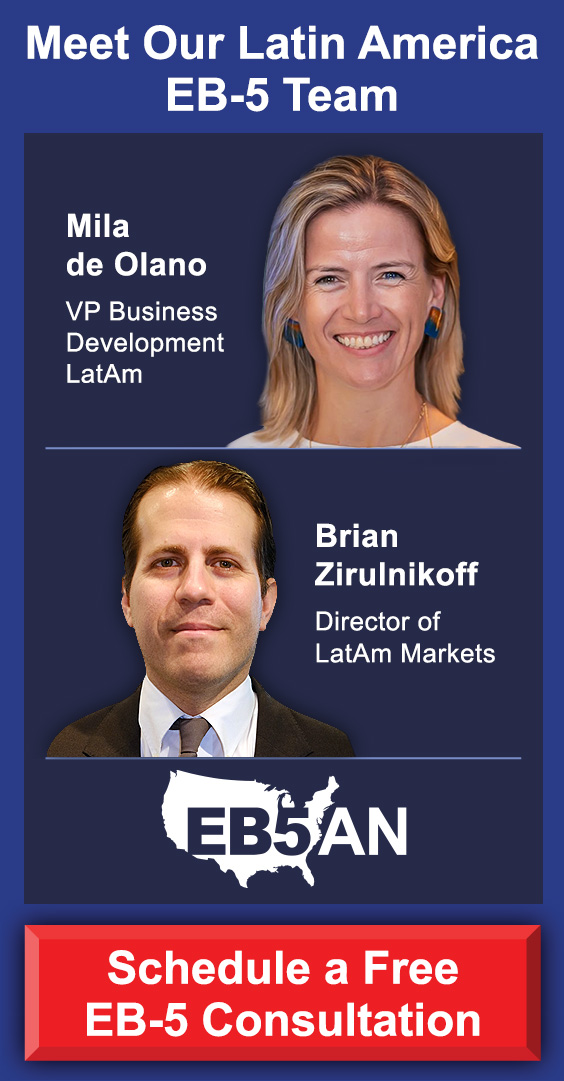If you’re seeking a Green Card for yourself and your eligible family members under the EB-5 Immigrant Investor Program, you need to get your Form I-526/I-526E immigrant petition approved. Ideally, you’ll receive that approval on a timeline that aligns with your plans to relocate to the United States.
Unfortunately, Form I-526/I-526E approval times can be hard to predict.
The United States introduced set-aside visa categories and reforms to United States Citizenship and Immigration Services (USCIS) that were intended to streamline processing. However, some foreign investors still face lengthy waits before their immigration petitions are processed.
In this article, we’ll explain what prospective EB-5 investors should understand about Form I-526/I-526E adjudication times, which factors affect these waiting times, and how to give yourself the best chance of a quick and smooth approval process.
What Is Form I-526/I-526E Approval?
What Is the Processing Time for Form I-526E?
- What Other Factors Affect I-526E Processing Times?
- I-526E Approval Doesn’t Guarantee a Green Card
- What Is the Priority Date of I-526E?
Invest in Transparent, Low-Risk Rural TEA Projects With EB5AN
What Is Form I-526/I-526E Approval?
Sending Form I-526 or Form I-526E to USCIS marks the moment someone officially applies to the EB-5 Immigrant Investor Program. USCIS reviews this application to determine whether an EB-5 applicant has made a qualifying investment to receive a conditional two-year Green Card.
This form is an essential part of the EB-5 application process. The main steps of this process are as follows:
- Confirm that a visa is available.
- Begin the EB-5 investment process.
- Submit Form I-526/I-526E (and either I-485 to adjust immigration status or DS-260 for consular processing) to gain your conditional Green Card.
- Keep your EB-5 immigrant investment allocated to the project for at least two years.
- File Form I-829 with USCIS during the last three months of the two-year conditional period.
- Await I-829 approval to remove conditions on the Green Cards for yourself and eligible family members.
You cannot complete this process and get an EB-5 Green Card without an approved Form I-526/I-526E.
What Is the Difference Between Form I-526 and I-526E?
Each EB-5 applicant must decide whether to invest in a U.S. business directly or via a USCIS-approved regional center. This choice will determine whether the investor submits Form I-526 or I-526E.
If you are one of the few who decide to invest directly, you’ll submit Form I-526 (Immigrant Petition by Standalone Investor).
A direct investment requires the participant to be actively involved in managing the business, including job creation. Direct investors have greater control over the business’s operations. There are no intermediaries, and a direct project has only one investor. Direct investments often apply to restaurants, schools, and other small- to moderate-sized enterprises.
If you are one of the many who decide to invest via a regional center, you’ll submit Form I-526E (Immigrant Petition by Regional Center Investor).
A regional center investment requires fewer decisions and less involvement in the management of the project from the investor. It also offers easier job creation requirements. Each regional center project typically has multiple investors. Regional center projects are often larger real estate developments, which are more easily funded by investor pooling.
What Is the Processing Time for Form I-526E?
USCIS aims to process all I-526E petitions within 240 days—roughly nine months.
However, the turnaround time can vary considerably. Some investors are approved in a few months. Others face a backlog and must wait for several years or longer. There are country caps on EB-5 visas; each country can receive no more than 7% of the total number of such visas each year.
Why You Should Consider Targeted Employment Area Projects
Typically, an EB-5 applicant must invest a minimum of $1,050,000 in an EB-5 project. However, they are eligible for a lower minimum investment of $800,000 for a project located in a targeted employment area (TEA).
What Are TEA Projects and Non-TEA Projects?
TEA projects offer this discounted rate because they are located in rural or high-unemployment areas, where there is a greater need for economic growth and job creation.
The EB-5 Reform and Integrity Act of 2022 (RIA) reserved 20% of the annual EB-5 visa quota for rural TEAs. A rural TEA is outside a metropolitan statistical area and a city or town with a population above 20,000.
Another 10% of such visas were allocated to high-unemployment TEAs. A high-unemployment TEA has an unemployment rate that is at least 150% of the U.S. national average.
Infrastructure projects receive 2% of the visas. The remaining 68% of EB-5 visas are unreserved visas. Chinese and Indian investors currently face backlogs under this category.
How Much Faster Are Rural TEA Category Project Applications Processed?
Rural category projects are especially attractive to some investors because they are eligible for priority processing. The latest data obtained through Freedom of Information Act requests show that USCIS has processed significantly more petitions for rural TEAs than for other EB-5 project categories.
For example, between April 1, 2022 and January 31, 2025, USCIS received a total number of 9,878 I-526E petitions. Even though applications for urban projects outnumbered those for rural projects, USCIS approved three times as many of the rural applications.
Between February 2023 and May 2025, USCIS adjudicated 74 urban project petitions. However, it adjudicated 967 rural petitions. That means 13 times as many rural petitions as urban petitions were processed, even though USCIS received more urban petitions during that time frame.
USCIS is also taking much longer to process urban project applications than it used to. In 2022, it adjudicated 268 urban petitions. However, it adjudicated only 93 urban petitions during the post-RIA time frame between 2023 and early 2025.
And as the number of urban project approvals has decreased, the number of rural project approvals has increased. In recent months, the number of rural TEA I-526E applications approved has surged. USCIS has approved almost all of these rural petitions in less than a year.
For the current fiscal year, about 4,274 visas are available for EB-5 rural TEA applicants. Every approved rural EB-5 investor could receive a Green Card without facing any visa backlog difficulties.
The adjudication statistics are clear. USCIS gives preferential treatment to rural I-526Es with faster average processing times because those projects have been selected for rural priority processing. We see no evidence of changes to these overall patterns in the new fiscal year.
What Other Factors Affect I-526E Processing Times?
Several other factors contribute to I-526E processing times, including the ones below:
- USCIS Resources: High application volumes, backlogs of pending cases, and USCIS staffing shortages can slow progress.
- Application Completeness and Accuracy: It’s important to include evidence that you’re making a qualifying investment in a commercial enterprise. An experienced attorney can help you complete your forms correctly and handle any legal challenges that may arise.
- Investor’s Background: The investor’s country of origin may cause delays if they are from a country like China or India, where the demand for visas is high and backlogs are likely. Doubts about whether the investor obtained their funds lawfully can also slow processing.
I-526E Approval Doesn’t Guarantee a Green Card
Receiving I-526E approval will not automatically grant you a Green Card.
USCIS limits the number of visas issued each year in each EB-5 category for each country. If the number of EB-5 applicants outstrips visa availability, some applicants will have to wait until the following year or longer.
To anticipate applicant wait times, it’s important to know how priority dates and final action dates work in the application process. You can find them on the Visa Bulletin website that belongs to the Department of State.
What Is the Priority Date of I-526E?
The priority date is the date when USCIS receives an EB-5 investor’s I-526E application. It’s like a place in line for an EB-5 visa.
The final action date is the date on the Visa Bulletin that shows when visas are available for an immigration category and country. It’s like a cutoff date for issuing visas.
If the Visa Bulletin shows that your priority date is earlier than the final action date, a visa is available. If the Visa Bulletin shows your priority date is later than the final action date, you have to keep waiting.
As of July 2025, all reserved EB-5 categories are current with no cutoff dates established, however, this might change soon.
Invest in Transparent, Low-Risk Rural TEA Projects With EB5AN
Qualified immigrants participating in the EB-5 program know that submitting an error-free I-526E immigration petition to USCIS is an essential part of a successful application.
USCIS has made rural visas a priority for processing. Choosing to invest in a rural TEA project will tilt the odds of a fast approval further in your favor, especially if you’re from a high-demand country like China and India.
Those planning to make an EB-5 investment in the near future should work with professionals who have a strong track record of success. In 2023 and 2024, around 20% of all EB-5 rural TEA project approvals went to the clients of one EB-5 firm: EB5AN.
EB5AN has helped more than 2,700 families from 70+ countries relocate to the United States as lawful permanent residents. Our expert team has more than a decade of experience, and offers clients first-rate, low-risk EB-5 regional center projects with 100% USCIS project approval rate to date.
To take the next step in your EB-5 journey, book a free call with us today.










